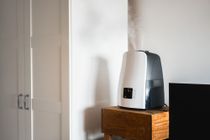4 Mistakes to Avoid When Using a Humidifier This Winter

The winter weather brings dry air, which can wreak havoc on the sinuses and indoor air quality. To combat this situation, many people use humidifiers, but moderation is key because overusing them can also be problematic. Too much humidity in the air can increase the growth of allergenic mold and other health hazards. Below are a few common mistakes people make in operating their humidifiers.
4 Humidifier Mistakes That Foster Allergenic Mold Growth
1. Forgetting to Check Humidity Levels
In addition to allowing mold to proliferate in the home, too much humidity can directly affect your health. For this reason, the Environmental Protection Agency has released guidelines for operating humidifiers in the home, stating that humidity levels should never exceed 50% in the winter.
While your humidifier may have a built-in humidistat, you can get more accurate readings by using a separate hygrometer.
2. Failing to Properly Clean the Unit
 If your symptoms worsen with the use of your humidifier and an indoor allergy test uncovers higher concentrations of allergens, your care of the humidifier may be to blame. It’s important to read the instructions for your humidifier and to follow suggestions for cleaning the tank and filters as frequently as the manufacturer recommends.
If your symptoms worsen with the use of your humidifier and an indoor allergy test uncovers higher concentrations of allergens, your care of the humidifier may be to blame. It’s important to read the instructions for your humidifier and to follow suggestions for cleaning the tank and filters as frequently as the manufacturer recommends.
Failing to follow these practices means allergens will accumulate in the filters and be redistributed in the treated air.
3. Using Tap Water
Your humidifier should be supplied with filtered or purified water. Although treated water represents a small additional cost, it’s necessary for the efficient operation of the unit.
When you fill the tank with regular tap water, you’re allowing sediment and minerals to collect in the filters and promote bacterial growth. That bacteria will be pushed out into the air your family breathes.
4. Letting Water Become Stagnant
Leaving the same water in your humidifier for days at a time will cause the water to become stagnant. You can tell this is happening when you notice a thin film forming on the walls of the tank. That film may breed bacteria.
To avoid this situation, the tank should be emptied when it’s not being used. Before refilling it with water for subsequent use, clean the tank with an anti-microbial agent and wipe it dry.
Allergenic mold growth is a problem that can affect homes even if they don’t use a humidifier. If your home is in need of mold remediation, or if you need water damage repaired, contact Piedmont Home Contractors Inc in Greensboro, NC. They have more than 24 years of experience and have earned the Better Business Bureau®’s highest A+ rating, so you can trust them to provide you with dedicated and skilled service. To learn more about mold remediation, visit the company online. Call (336) 545-8812 to speak with one of their customer service representatives.
About the Business
Have a question? Ask the experts!
Send your question

